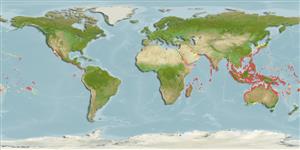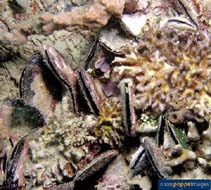Isognomon isognomum (Linnaeus, 1758)
Wader tree oyster| Native range | All suitable habitat | Point map | Year 2050 |

|
| This map was computer-generated and has not yet been reviewed. |
| Isognomon isognomum AquaMaps Data sources: GBIF OBIS |
Classification / Names Common names | Synonyms | CoL | ITIS | WoRMS
Bivalvia | Ostreida | Isognomonidae
Environment: milieu / climate zone / depth range / distribution range Ecology
Benthic; depth range 0 - 20 m (Ref. 348). Tropical
Distribution Countries | FAO areas | Ecosystems | Occurrences | Introductions
Indo-Pacific: from East Africa, to eastern Polynesia; north to southern Japan and south to Queensland.
Length at first maturity / Size / Weight / Age
Maturity: Lm ? range ? - ? cm Max length : 15.0 cm ShL male/unsexed; (Ref. 348); common length : 10.0 cm SL male/unsexed; (Ref. 348)
Short description Morphology
Shell relatively high and narrow in outline, with undulating commissure and strong posteroventral elongation. Shape often very irregular, due to the confined space in which the shell grows and to the effect of repair. Dorsal margin long and straight to slightly arched, more or less strongly expanded posteriorly in a wing-like ear that increases with growth and may attain a size double the length of shell. Anterior margin elongated, markedly sinuous dorsally and extending a little or not at all forward of umbones. Posterior margin concave near the posterior ear, then more or less parallel to anterior margin. Ventral margin roughly rounded. Umbones small, pointing at anterior end of dorsal margin. Outer surface with irregularly concentric lamellate processes, often encrusted with marine growths and corroded towards the umbones. Ligamental area with numerous transverse grooves (more than 20 in large specimens). Nacreous area of the inner side of shell more or less expanded ventrally, its margin often poorly defined. Colour: outside of shell bluish purple to almost black, often paler to whitish umbonally. Interior porcelaneous and similarly coloured on non-nacreous area; nacreous area much paler, with bluish purple hue.
Byssally attached to hard substrates, with the shell vertically disposed and the dorsal margin lying on the rock surface, or to boulders and corals. Often occurs in dense colonies (maximum recorded density of about 870 individuals/m2), sometimes forming mixed natural beds with Malleus regula. Littoral and sublittoral (Ref. 348).
Life cycle and mating behavior Maturity | Reproduction | Spawning | Eggs | Fecundity | Larvae
Members of the class Bivalvia are mostly gonochoric, some are protandric hermaphrodites. Life cycle: Embryos develop into free-swimming trocophore larvae, succeeded by the bivalve veliger, resembling a miniature clam.
Main reference
References | Coordinator | Collaborators
Poutiers, J.M. 1998. (Ref. 348)
IUCN Red List Status (Ref. 130435)
CITES status (Ref. 108899)
Not Evaluated
CMS (Ref. 116361)
Not Evaluated
Threat to humans
Harmless
Human uses
| FishSource |
Tools
More information
Internet sources
BHL | BOLD Systems | CISTI | DiscoverLife | FAO(Publication : search) | Fishipedia | GenBank (genome, nucleotide) | GloBI | Gomexsi | Google Books | Google Scholar | Google | PubMed | Tree of Life | Wikipedia (Go, Search) | Zoological Record
Estimates based on models
Preferred temperature
(Ref. 115969): 24.4 - 29.3, mean 28.4 (based on 3576 cells).
Price category
(Ref. 80766):
Unknown.



